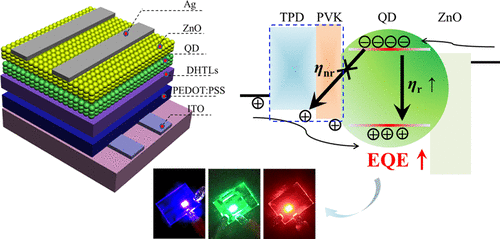当前位置:
X-MOL 学术
›
ACS Appl. Mater. Interfaces
›
论文详情
Our official English website, www.x-mol.net, welcomes your
feedback! (Note: you will need to create a separate account there.)
Small Molecule-Modified Hole Transport Layer Targeting Low Turn-On-Voltage, Bright, and Efficient Full-Color Quantum Dot Light Emitting Diodes
ACS Applied Materials & Interfaces ( IF 8.3 ) Pub Date : 2018-01-16 00:00:00 , DOI: 10.1021/acsami.7b16261 Jingling Li 1, 2, 3 , Zheng Liang 1, 2 , Qiucheng Su 1, 2 , Hu Jin 1, 2, 4 , Kelai Wang , Gang Xu 1, 2, 3 , Xueqing Xu 1, 2, 3, 4
ACS Applied Materials & Interfaces ( IF 8.3 ) Pub Date : 2018-01-16 00:00:00 , DOI: 10.1021/acsami.7b16261 Jingling Li 1, 2, 3 , Zheng Liang 1, 2 , Qiucheng Su 1, 2 , Hu Jin 1, 2, 4 , Kelai Wang , Gang Xu 1, 2, 3 , Xueqing Xu 1, 2, 3, 4
Affiliation

|
For an organic–inorganic hybrid quantum dot light-emitting diode (QD-LED), enhancing hole injection into the emitter for charge balance is a priority to achieve efficient device performance. Aiming at this, we employ N,N′-bis(3-methylphenyl)-N,N′-bis(phenyl)benzidine (TPD) as the additional hole transport material which was mixed with poly(9-vinylcarbazole) (PVK) to form a composite hole transport layer (HTL) or was employed to construct a TPD/PVK bilayer structure. Enabled by this TPD modification, the green QD-LED (at a wavelength of 515 nm) exhibits a subband gap turn-on voltage of 2.3 V and a highest luminance up to 56 157 cd/m2. Meanwhile, such TPD modification is also beneficial to acquire efficient blue and red QD-LEDs. In particular, the external quantum efficiencies (EQEs) for these optimized full-color QD-LEDs are 8.62, 9.22, and 13.40%, which are 3–4 times higher than those of their pure PVK-based counterparts. Revealed by the electrochemical impedance spectroscopy, the improved electroluminescent efficiency is ascribable to the reductions of recombination resistance and charge-transfer resistance. The prepared QD-LEDs surpass the EQE values achieved in previous reports, considering devices with small-molecule-modified HTLs. This work offers a general but simple and very effective approach to realize the low turn-on-voltage, bright, and efficient full-color QD-LEDs via this solution-processable HTL modification.
中文翻译:

小分子修饰的空穴传输层,以低开启电压,明亮和高效的全色量子点发光二极管为目标
对于有机-无机混合量子点发光二极管(QD-LED),增强射入发射极的空穴以实现电荷平衡是实现高效器件性能的首要任务。为此,我们使用N,N'-双(3-甲基苯基)-N,N'-双(苯基)联苯胺(TPD)作为附加的空穴传输材料,将其与聚(9-乙烯基咔唑)(PVK)混合形成复合空穴传输层(HTL)或用于构建TPD / PVK双层结构。通过此TPD修改,绿色QD-LED(波长为515 nm)表现出2.3 V的子带隙开启电压和最高56 157 cd / m 2的最高亮度。同时,这种TPD修饰也有利于获得有效的蓝色和红色QD-LED。特别是,这些优化的全色QD-LED的外部量子效率(EQE)为8.62%,9.22%和13.40%,是其纯基于PVK的同类产品的3-4倍。通过电化学阻抗谱显示,提高的电致发光效率归因于重组电阻和电荷转移电阻的降低。考虑到具有小分子修饰HTL的器件,准备好的QD-LED超过了先前报告中获得的EQE值。这项工作提供了一种通用但简单且非常有效的方法,通过这种可解决方案的HTL修改来实现低导通电压,明亮且高效的全色QD-LED。
更新日期:2018-01-16
中文翻译:

小分子修饰的空穴传输层,以低开启电压,明亮和高效的全色量子点发光二极管为目标
对于有机-无机混合量子点发光二极管(QD-LED),增强射入发射极的空穴以实现电荷平衡是实现高效器件性能的首要任务。为此,我们使用N,N'-双(3-甲基苯基)-N,N'-双(苯基)联苯胺(TPD)作为附加的空穴传输材料,将其与聚(9-乙烯基咔唑)(PVK)混合形成复合空穴传输层(HTL)或用于构建TPD / PVK双层结构。通过此TPD修改,绿色QD-LED(波长为515 nm)表现出2.3 V的子带隙开启电压和最高56 157 cd / m 2的最高亮度。同时,这种TPD修饰也有利于获得有效的蓝色和红色QD-LED。特别是,这些优化的全色QD-LED的外部量子效率(EQE)为8.62%,9.22%和13.40%,是其纯基于PVK的同类产品的3-4倍。通过电化学阻抗谱显示,提高的电致发光效率归因于重组电阻和电荷转移电阻的降低。考虑到具有小分子修饰HTL的器件,准备好的QD-LED超过了先前报告中获得的EQE值。这项工作提供了一种通用但简单且非常有效的方法,通过这种可解决方案的HTL修改来实现低导通电压,明亮且高效的全色QD-LED。











































 京公网安备 11010802027423号
京公网安备 11010802027423号